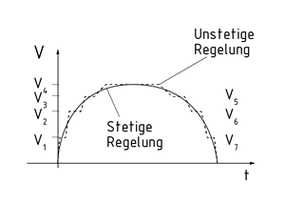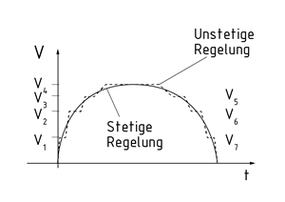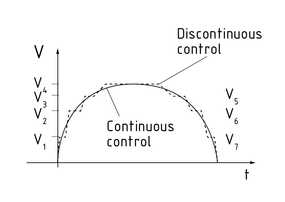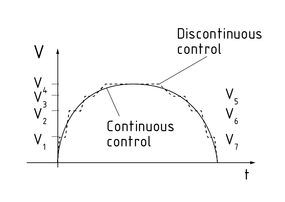
Choose one
or multiple languages
0,1,1
- German
- English
- Chinese
- Spanish
Continuous controllers

Continuous controllers act on the closed-loop control circuit on an uninterrupted basis and convey a continuous signal to the Actuator. P, I and D elements are well-established continuous control elements.
Continuous control can be illustrated using the example of a tool carriage that is first to be started up and then slowed down again. In the case of a discontinuous multi-position controller, the carriage is first accelerated to V1, V2 and V3 before it reaches its maximum Velocity V4. During deceleration, the velocity is reduced to V5, V6 and V7.
In the case of a continuous control system, the carriage's Acceleration is adapted on an ongoing basis throughout the process. Low positive and negative acceleration values occur. When plotting the velocity over time, clear steps are visible in the first case, whereas a smooth curve is produced in the second case.
The advantages of continuous control include avoiding switching shocks. The system is also more flexible, because the control device can assume any desired value within the pre-specified technical limits.
Stetige Regler

Stetige Regler greifen ununterbrochen in den Regelkreislauf ein und geben kontinuierlich ein Signal an die Stelleinrichtung. Bekannte stetige Regelglieder sind P-, I- und D-Glieder.
Anschaulich wird die stetige Regelung am Beispiel eines Werkzeugschlittens, der zunächst angefahren und anschließend wieder gebremst werden soll. Beim unstetigen Mehrpunktregler wird der Schlitten zunächst auf V1, V2 und V3 beschleunigt, ehe er seine Höchstgeschwindigkeit V4 erreicht. Beim Abbremsen wird die Geschwindigkeit auf V5, V6 und V7 reduziert.
Bei einer stetigen Regelung wird die Beschleunigung des Schlittens kontinuierlich über die gesamte angepasst. Es treten geringe positive wie auch negative Beschleunigungswerte auf. Bei der Darstellung der Geschwindigkeit über die Zeit sind im ersten Fall deutliche Stufen zu erkennen, während im zweiten Fall eine harmonische Kurve zu sehen ist.
Vorteile der stetigen Regelung sind unter anderem die Vermeidung von Schaltschlägen. Des Weiteren ist die Anlage flexibler, da die Regeleinrichtung beliebige Werte innerhalb vorgegebener technischer Grenzen einnehmen kann.
连续控制器

连续控制器将在不间断的基础上,在闭环控制电路中进行控制操作,并向执行机构传递连续信号。比例、积分和微分元件都是行之有效的连续控制元件。
连续控制可以使用工具托架作为例子来说明,这里首先启动工具托架,然后再将速度减慢。在不连续的多位置控制器的情况下,托架先加速到 V1、 V2 和 V3,然后达到其最大速度 V4。在减速的时候,托架会减速到 V5、V6 和 V7。
在连续控制系统的情况下,在整个过程中,托架的加速过程是持续进行的。其中会出现较低的加速度。当绘制随时间变化速度的时候,在第一种情况是清晰的几个步骤,而在第二种情况下产生的则是平滑曲线。
连续控制的优点包括避免切换冲击。同时,在预先指定的技术范围内,因为控制装置可以设定为任何所需的值,因此系统也变得更加灵活。
连续控制系统和非连续控制系统的比较
近义词
线性控制器
controladores continuos

Los controladores continuos actúan en el circuito de control de bucle cerrado de manera ininterrumpida y transmiten una señal continua hacia el actuador. Los elementos P, I y D son elementos de control continuo bien establecidos.
El control continuo puede ser ilustrado usando el ejemplo de un carro de herramientas que debe ser primero arrancado y luego desacelerado. En el caso de un control discontinuo multiposición, el carro es primero acelerado a V1, V2 y V3 antes de que llegue a su velocidad máxima V4. Durante la desaceleración, la velocidad es reducida a V5, V6 y V7.
En el caso de un sistema de control continuo, la aceleración del carro es adaptada de manera continua a lo largo del proceso. Durante el proceso, ocurren valores de aceleración positiva y negativa bajos. Cuando se traza la velocidad en el tiempo, los pasos claros son visibles en el primer caso, mientras que una curva suave es producida en el segundo caso.
Las ventajas de un control continuo incluyen la evitación de choques de conmutación. El sistema también es más flexible, ya que el dispositivo de control puede asumir cualquier valor deseado dentro de los límites técnicos especificados previamente.
Comparación de controladores continuos y discontinuos
